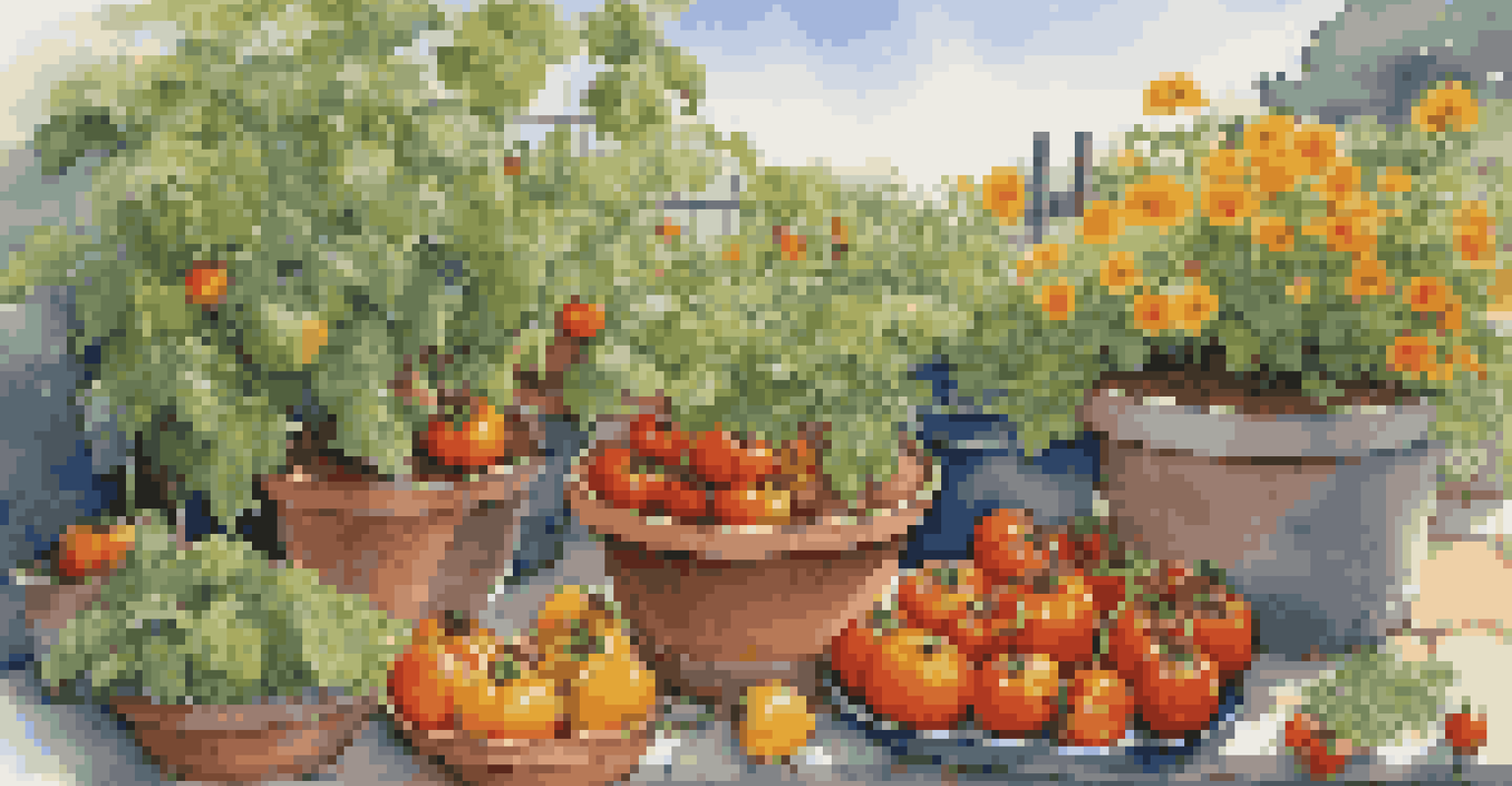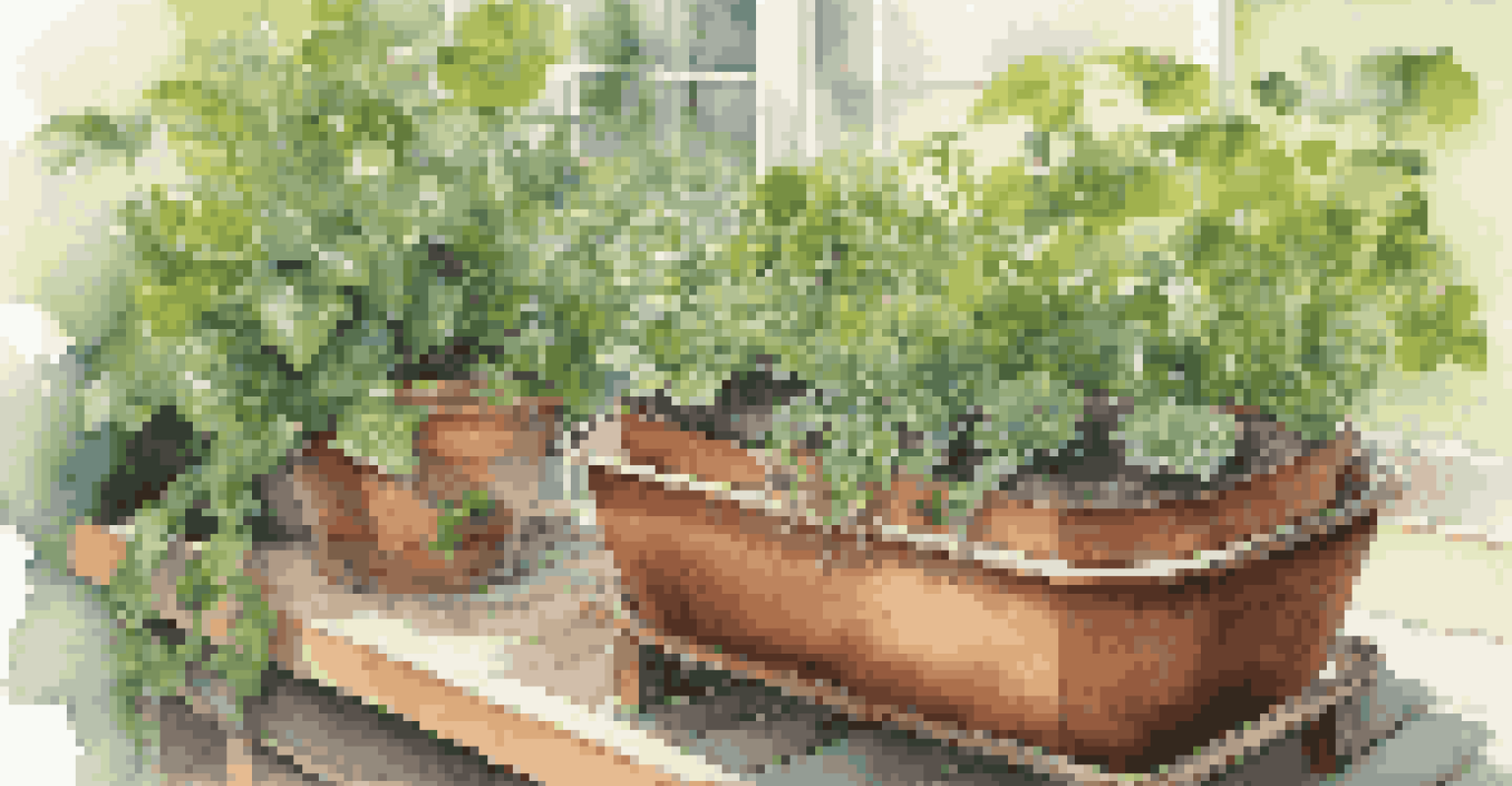Container Gardening: How to Choose the Right Plants

Understanding Your Space: Light and Environment Matters
Before diving into container gardening, assess your available space. Consider how much sunlight your area receives each day. Most plants need at least six hours of direct sunlight, so knowing your garden's light conditions is crucial.
To plant a garden is to believe in tomorrow.
Take note of any shaded areas and how they change throughout the day. If your balcony gets morning sun but is shaded by afternoon, you'll want to choose plants that thrive in partial sun. This understanding helps you select plants that will flourish in their designated spots.
Don't forget about the wind and temperature extremes that can affect container gardens. If your space is windy or prone to frosts, you might need to protect sensitive plants or choose hardier varieties that can withstand those conditions.
Choosing the Right Size Containers for Your Plants
The size of your containers plays a significant role in plant growth. A larger pot can hold more soil, which means better moisture retention and root expansion. This is especially important for plants that tend to grow tall or wide.

For smaller plants like herbs or flowers, a pot that’s around 8-12 inches in diameter is usually sufficient. However, for larger plants like tomatoes or peppers, aim for at least 5 gallons of soil capacity to give their roots room to spread.
Assess Light and Space for Success
Understanding your garden's light conditions and layout is essential for selecting the right plants.
Additionally, ensure your containers have drainage holes to prevent waterlogging, which can lead to root rot. Choosing the right size not only supports healthy growth but also makes for a visually appealing arrangement in your garden.
Selecting Plants Based on Your Gardening Goals
Consider what you want to achieve with your container garden. Are you hoping to grow vegetables for home cooking, or are you looking to create a beautiful floral display? Your goals will guide your plant selection.
Gardening adds years to your life and life to your years.
If you're interested in growing your own food, think about planting herbs like basil or cilantro, which are perfect for containers. For a more decorative approach, consider vibrant flowers such as petunias or geraniums that can brighten up any space.
Remember to choose plants that complement each other. For example, consider a combination of tall plants in the center, surrounded by trailing varieties that spill over the edges for a beautiful layered effect.
Considering Plant Compatibility: Companion Planting
Companion planting involves growing different plants together that can benefit one another. Some plants can repel pests, while others can enhance growth through nutrient sharing. This practice is especially useful in container gardening, where space is limited.
For instance, basil is known to enhance the flavor of tomatoes and can help deter tomato hornworms. Planting marigolds alongside vegetables can repel harmful insects, creating a natural pest control system.
Choose Containers Wisely
Selecting the appropriate container size and ensuring proper drainage are crucial for healthy plant growth.
When arranging your plants, think about their growth habits and needs. Grouping plants with similar water and light requirements not only makes care easier but also maximizes your garden's potential.
Seasonal Plant Selection: What to Plant When
Timing is key in container gardening. Different plants thrive in different seasons, so it's essential to know when to plant. For example, cool-season crops like lettuce and peas can be planted in early spring, while warm-season plants like peppers and tomatoes should wait until after the last frost.
Consider rotating your plants seasonally to maintain a vibrant and productive garden. You can start with spring blooms, transition to summer vegetables, and finish with fall harvests like pumpkins or winter greens.
By planning your planting schedule, you can maximize your garden's output and enjoy a variety of flavors and colors throughout the year.
Soil Selection: The Foundation of Healthy Plants
The type of soil you use in your containers can greatly influence plant health. Opt for high-quality potting soil, which is specially formulated to provide good drainage and aeration. This is essential because container plants can suffer from root rot if soil retains too much moisture.
Consider using a soil mix that includes organic materials like compost or coconut coir, as they provide nutrients and improve soil structure. Additionally, ensure your soil is free from pests and diseases by purchasing from reputable sources.
Plan for Seasonal Planting
Timing your planting according to seasonal changes can maximize your garden's productivity and variety.
Regularly refreshing your soil can also help maintain nutrient levels. Each season, consider adding a slow-release fertilizer or organic amendments to keep your plants thriving.
Watering Wisely: Maintaining Moisture Levels
Watering is one of the most critical aspects of container gardening. Since containers can dry out more quickly than garden beds, it's vital to establish a consistent watering schedule. A good rule of thumb is to check the top inch of soil; if it feels dry, it's time to water.
Consider using self-watering containers to help regulate moisture levels, especially during hot summer months. These containers have a reservoir system that provides a steady supply of water to plant roots, reducing the frequency of watering.

Additionally, be mindful of the type of plants you choose, as some require more water than others. Grouping plants with similar watering needs can simplify your routine and promote healthier growth.
Experimenting and Enjoying Your Container Garden Journey
One of the most enjoyable aspects of container gardening is the opportunity to experiment. Don’t be afraid to try new plants or arrange them in different ways. Gardening is as much about creativity as it is about cultivation.
Keep a garden journal to track what works and what doesn’t. Documenting your successes and failures will provide valuable insights for future growing seasons and can help you refine your approach.
Lastly, remember to enjoy the process. Container gardening is a rewarding hobby that connects you with nature and can yield delicious produce or stunning blooms. Celebrate every little victory and embrace the learning experience!